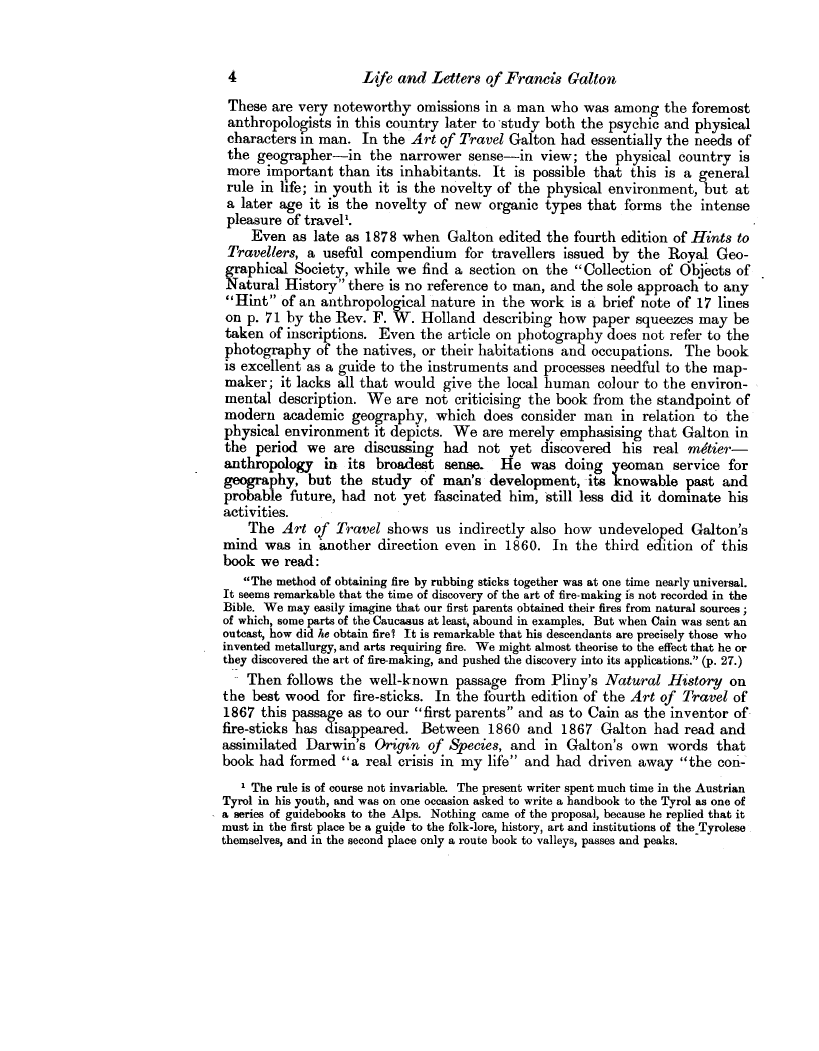4 Life and Letters of Francis Galton
These are very noteworthy omissions in a man who was among the foremost anthropologists in this country later to -study both the psychic and physical characters in man. In the Art of Travel Galton had essentially the needs of the geographer-in the narrower sense-in view; the physical country is more important than its inhabitants. It is possible that this is a general rule in life; in youth it is the novelty of the physical environment, but at a later age it is the novelty of new organic types that forms the intense pleasure of travel'.
Even as late as 1878 when Galton edited the fourth edition of Hints to Travellers, a useful compendium for travellers issued by the Royal Geographical Society, while we find a section on the "Collection of Objects of Natural History" there is no reference to man, and the sole approach to any "Hint" of an anthropological nature in the work is a brief note of 17 lines on p. 71 by the Rev. F. W. Holland describing how paper squeezes may be taken of inscriptions. Even the article on photography does not refer to the photography of the natives, or their habitations and occupations. The book is excellent as a guide to the instruments and processes needful to the mapmaker; it lacks all that would give the local human colour to the environmental description. We are not criticising the book from the standpoint of modern academic geography, which does consider man in relation to the physical environment it depicts. We are merely emphasising that Galton in the period we are discussing had not yet discovered his real metieranthropology in its broadest sense. He was doing yeoman service for geography, but the study of man's development, its knowable past and probable future, had not yet fascinated him, 'still less did it dominate his activities.
The Art of Travel shows us indirectly also how undeveloped Galton's mind was in another direction even in 1860. In the third edition of this book we read
"The method of obtaining fire by rubbing sticks together was at one time nearly universal. It seems remarkable that the time of discovery of the art of fire-making is not recorded in the Bible. We may easily imagine that our first parents obtained their fires from natural sources ; of which, some parts of the Caucasus at least, abound in examples. But when Cain was sent an outcast, how did he obtain fire? It is remarkable that his descendants are precisely those who invented metallurgy, and arts requiring fire. We might almost theorise to the effect that he or
they discovered the art of fire-making, and pushed the discovery into its applications." (p. 27.)
Then follows the well-known passage from Pliny's Natural History on the best wood for fire-sticks. In the fourth edition of the Art of Travel of 1867 this passage as to our "first parents" and as to Cain as the inventor offire-sticks has disappeared. Between 1860 and 1867 Galton had read and assimilated Darwin's Origin of Species, and in Galton's own words that book had formed "a real crisis in my life" and had driven away "the con
1 The rule is of course not invariable. The present writer spent much time in the Austrian Tyrol in his youth, and was on one occasion asked to write a handbook to the Tyrol as one of a series of guidebooks to the Alps. Nothing came of the proposal, because he replied that it must in the first place be a guide to the folk-lore, history, art and institutions of the Tyrolese themselves, and in the second place only a route book to valleys, passes and peaks.

